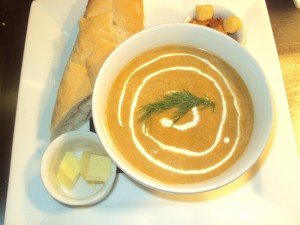The word restaurant ( or restoratif ) was first used in sixteenth century France to describe a cheap, concentrated soup or broth served by street vendors. It was marketed with almost miraculous properties, said to be able to cure exhaustion, the word means ‘something restoring’, and from the very earliest times, a soup or potage was often the staple diet of invalids due to it being able to be easily digested. Most cultures have an example of this tradition in some form, the cure all kosher chicken soup or the squaddie sipping beef bullion from a cube or paste.
These early soups probably bore little resemblance to what we eat today made from a few carefully chosen fresh ingredients. The word restaurant as we use it today, took on the modern association in the 1760’s when a Parisian shopkeeper started serving pots of soup on his premises. As French gastronomy developed so did the soup from the traditional hearty Pot-au-feu becoming elegant, refined Consommé, luxurious cream-based velouté and velvety puréed vegetable classics.
The word soup is most certainly derived from the Latin suppa meaning ‘ bread soaked in broth ‘. There is probably little to distinguish early soups from stews, made with whatever ingredients were available, meat scraps, bones, vegetables, maybe grains and lots of herbs. The pot would hang over the fire and cook for several hours. The French Petite Marmite is perhaps the closest we have to these early soup dishes, the aromatic meat and vegetable broth served in the pot in which it is cooked.
From a culinary perspective, soups can be broken down into four groups, broths and Consommé such as Cock-a-leekie. Vegetable purées such as tomato, curried parsnip or carrot and coriander. Thickened soups such as Mulligatawny, using rice or a traditional chicken velouté made with stock and a roux. The last group is the soup / stews like the Petite Marmite and rustic Minestrone.
Preprepared Soups
The first concentrated, portable soups were devised, mostly likely by trial and error in the eighteenth century by reducing stocks down to form a very thick syrup that could then be dried out and stored. Today the Japanese make their favourite miso soup is from concentrated pastes. Commercially made soups really came of age with the development of canning, Americans consume approximately two and a half billion bowls of the Campbell’s Soup Company condensed soups three most popular flavours Tomato, Cream of Mushroom, and Chicken Noodle Soup alone. Microwaveable bowls have further expanded the ready-to-eat soup market, even more, offering an almost instant, convenience food.
The concept of dried food is not particularly new but it was not until the twentieth century and vacuum technology allowed scientists to perfect freeze-drying or dehydrating food stuffs. Maxwell House developed a technique to produce coffee granules in 1963. The rest of the food industry soon saw the potential and powdered soups grew to account for just under twenty-five percent of the UK market by 2000.* Food manufacturers continue to innovate and changes in packaging saw the growth of fresh soups and today Heinz are introducing soup pastes to replace powder bases.
* Fresh chilled soups, however, still only accounted for 14.4% of retail soup sales in 2000, compared to 61.5% for ambient wet (mostly canned soups) and dry soups, 23.6%. The relatively small size of the sector was reflected by only 13% of adults interviewed agreeing that chilled soups in cartons were actually better quality than canned soups.
The Soup Market Market Assessment Key Note Publications Ltd, January 2001
The Recipe
I make soup regularly and always have onions, garlic, leeks and celery to hand to add some base flavours to whatever soup I am making. A stick blender or food processor quickly makes light work of pureeing the cooked vegetables into a smooth soup. The rest of the ingredients are pretty common and essential in a well-stocked kitchen. The secret to this classic is a spoonful of marmalade to add a little extra sweetness and an orange undertone to the finished soup.
Carrot and Coriander Soup serves 4
1 kg carrots, peeled and roughly chopped
2 large Onions, peeled and roughly chopped
3 sticks of Celery, washed and roughly chopped
2 cloves of Garlic, peeled and chopped
50 ml quality Olive Oil
1 litre of Water or light Chicken or Vegetable Stock if available
2 tablespoons thick cut Orange Marmalade
1 tablespoon Coriander Seeds
Sea Salt and freshly ground Black Pepper
Heat the oil in a large, heavy bottomed pan and sauté the vegetables and garlic for ten minutes until soft without colouring. Toast the coriander seeds in a small pan or under the grill for a couple of minutes to release the essential oils then blitz in a food processor. Add to the vegetables along with the water and marmalade. Bring to the boil, cover with a tight-fitting lid and simmer for twenty minutes. Take off the heat and allow to cool for a while before blending in a food processor or with a stick blender. Correct the seasoning and return to the heat to warm thoroughly before serving. You can finish with a little cream if you are feeling decadent and some chopped fresh coriander leaves.


Pingback: A Bonfire Night Treat – Roasted Red Pepper Soup » Frost Magazine